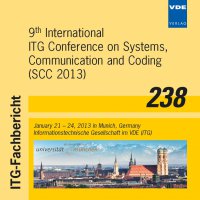Design of LDPC Codes for Hybrid 10 Gbps/100 Gbps Optical Systems with Optional Differential Modulation
Conference: SCC 2013 - 9th International ITG Conference on Systems, Communication and Coding
01/21/2013 - 01/24/2013 at München, Deutschland
Proceedings: SCC 2013
Pages: 6Language: englishTyp: PDF
Personal VDE Members are entitled to a 10% discount on this title
Authors:
Pflueger, Doris; Bauch, Gerhard (Institute of Information Processing, Universität der Bundeswehr München, Germany)
Hauske, Fabian N.; Yu, Zhao (European Research Center, Huawei Technologies Düsseldorf GmbH, Germany)
Abstract:
For 100 Gbit/s fiber optical long-haul transmission systems, digital signal processing and forward error correction (FEC) coding play an increasingly important role. A major problem for actually desired coherent detection is the occurrence of phase slips caused by imperfect carrier phase recovery. Differential modulation can help to overcome the problem of phase slips on the expense of a performance degradation referred to as differential penalty. On the other hand, differential modulation allows to apply an iterative detection scheme, where extrinsic information is exchanged among FEC decoder and differential detector. In this paper, we address the fundamental question, under which conditions with respect to code rate and complexity it is possible to design irregular low density parity check (LDPC) codes which allow to compensate or even overcompensate for the differential penalty by turbo iterations. The optimum LDPC codes are in general different for coherent and differential detection. However, e.g. in hybrid 100 Gbit/s channels with adjacent 10 Gbit/s channels differential detection is preferred due to the high phase slip probability. In contrast, pure 100 Gbit/s channels typically do not require differential decoding. Therefore, the operators wish to switch between coherent and differential transmission depending on the current channel conditions without changing the FEC code. The main contribution of the paper is the extrinsic information transfer (EXIT) chart based design and analysis of LDPC codes which provide the best performance in both differential and nondifferential detection.


